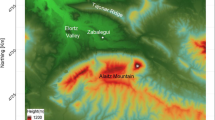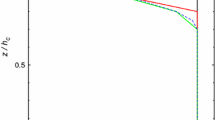Abstract
Surface-based and aircraft measured fluxes over the heterogeneous surface in HAPEX-MOBILHY are analyzed for the ten flight days when cloud cover above the boundary layer was minimal. The fair-weather climatology of the spatial variation of surface fluxes is estimated to provide an assessment of the generality of previous case studies appearing in the literature. For the 10-day averages, greater heating over the forest generates a forest breeze which leads to rising motion and a modest increase of boundary-layer cloud cover at the forest edge. The exchange coefficients and effective roughness lengths are computed for local averages (15 km scale) and for regional averages (100 km scale) intended to represent a range of grid sizes in numerical models of the atmosphere. The effective roughness length for momentum over the mixed agricultural region for both scales is on the order of 1 m, apparently due to bluff roughness effects associated with scattered trees, edges of small woods and other obstacles. This roughness length value is an order of magnitude larger than values used in numerical models for the same region, which are based on the dominant vegetation type. The spatially varying effective roughness length for heat is computed for use in those models which use surface radiation temperature to estimate surface heat flux. The effective roughness lengths for heat are found to be smaller than those typically used in numerical models of the atmosphere.
Similar content being viewed by others
References
André, J. C. and collaborators: 1988, ‘Evaporation Over Land-Surfaces, First Results from HAPEX-MOBILHY Special Observing Period’,Ann. Geophys. B 6, 477–492.
André, J. C., Bougeault, P., Mafouf, J.-F., Mascart, P., Noihan, J., and Pinty, J.-P.: 1989, ‘Impact of Forests on Mesoscale Meteorology’,Phil. Trans. R. Soc. Lond. B324, 407–422.
André, J.-C., Bougeault, P. and Goutorbe, J.-P.: 1990 ‘Regional Estimates of Heat and Evaporation Fluxes Over Non-Homogeneous Terrain, Examples from the HAPEX-MOBILHY Programme’,Boundary-Layer. Meteorol. 50, 77–108.
Bechtold, P., Pinty, J.-P., and Mascart, P.: 1993, ‘A Numerical Investigation of the Influence of Large-Scale Winds on Sea Breeze and Inland Breeze Type Circulations’, to appear inJ. Appl. Meteorol.
Beljaars, A. C. M., and Holtslag, A. A. M.: 1991, ‘Flux Parameterization Over Land Surfaces for Atmospheric Models’,j. Appl. Meteorol. 30, 327–341.
Ben Mehrez, M., Taconet, O., Vidal-Madjar, D., and Sucksdorff, Y.: 1992, ‘Calibration of an Energy Flux Model Over Bare Soils During the HAPEX-MOBILHY Experiment’,Agric. For. Meteorol. 58, 257–283.
Bougeault, P., Bret, B., Lacarrère, P., and Noilhan, J.: 1991, ‘An Experiment with an Advanced Surface Parameterization in a Mesobeta-Scale Model, Part II: The 16 June 1986 Simulation’,Mon. Wea. Rev. 119, 2374–2392.
Bradley, E. F.: 1968, ‘A Micrometeorological Study of Velocity Profiles and Surface Drag in the Region Modified by a Change in Surface Roughness’,Quart. J. Roy. Meteorol. Soc. 94, 361–379.
Brutsaert, W. H.: 1982,Evaporation into the Atmosphere, D. Reidel, Dordrecht, 299 pp.
Claussen, Martin: 1990, ‘Area-Averaging of Surface Fluxes in a Neutrally Stratified, Horizontally Inhomogeneous Atmospheric Boundary Layer’,Atmos. Envir. 24A, 1349–1360.
Claussen, Martin: 1992, ‘Scale Aggregation in Semi-Smooth Flow’, submitted toJ. of Hydrology. Also Report No. 87, Max-Planck-Institut für Meteorologie, Bundesstr. 55, 2 Hamburg 13, Germany.
Claussen, Martin and Klaassen, Wim: 1992, ‘On Regional Surface Fluxes Over Partly Forested Areas’,Contributions to Atmospheric Physics 65, 243–248.
Fazu, Chen and Schwerdtfeger, Peter: 1989, ‘Flux-Gradient Relationships for Momentum and Heat Over a Rough Natural Surface’,Q. J. Roy. Meteorol. Soc. 115, 335–352.
Garratt, J. R.: 1980, ‘Surface Influence Upon Vertical Profiles in the Atmospheric Near-Surface Layer’,Q. J. R. Meteorol. Soc. 106, 803–819.
Garratt, J. R.: 1992,The Atmospheric Boundary Layer, Cambridge University Press, 316 pp.
Garratt, J. R. and Hicks, B. B.: 1973, ‘Momentum, Heat and Water Vapour Transfer to and from Natural and Artificial Surfaces’,Q. J. Roy. Meteorol. Soc. 99, 680–687.
Garratt, J. R., Peilke, R. A., Miller, W. F., and Lee, T. J.: 1990, ‘Mesoscale Model Response to Random Surface-Based Perturbations — a Sea-Breeze Experiment’,Boundary-Layer Meteorol. 52, 313–334.
Gash, J. H. C., Shuttleworth, W. J., Lloyd, C. R., André, J.-C., Goutorbe, J.-P., and Gelpe, J.: 1989, ‘Micrometeorological Measurements in Les Landes Forest During HAPEX-MOBILHY’,Agric. For. Meteorol. 46, 131–147.
Goutorbe, J.-P.: 1991, ‘A Critical Assessment of the SAMER Network Accuracy’, in Thomas J. Schmugge and Jean-Claude André (eds.),Land Surface Evaporation. Measurement and Parameterization, Springer Verlag, pp. 171–182.
Grant, A. L. M.: 1991, ‘Surface Drag and Turbulence Over an Inhomogeneous Land Surface’,Boundary-Layer Meteorol. 56, 309–337.
Hadfield, M. G., Cotton, W. R., and Pielke, R. A.: 1992, ‘Large-Eddy Simulations of Thermally Forced Circulations in the Convective Boundary Layer’, Part II: ‘The Effect of Changes in Wavelength and Wind Speed’,Boundary-Layer Meteorol. 58, 307–327.
Hildebrand, P. H.: 1988, ‘Flux and Sounding Data from the NCAR King Air Aircraft During HAPEX’, NCAR Technical Rept. TN-319, NCAR Boulder, CO 80307, USA.
Hildebrand, P. H.: 1991, ‘Errors in Eddy Correlation Turbulence Measurements from Aircraft: Application to HAPEX-MOBILHY’, in Thomas J. Schmugge and Jean-Claude André (eds.),Land Surface Evaporation. Measurement and Parameterization, Springer Verlag, pp. 231–243.
Klaassen, W.: 1992, ‘Average Fluxes from Heterogeneous Vegetated Regions’,Boundary-Layer Meteorol. 58, 329–354.
Louis, J.-F.: 1979, ‘A Parametric Model of Vertical Eddy Fluxes in the Atmosphere’,Boundary-Layer Meteorol. 17, 187–202.
Mahrt, L.: 1987, ‘Grid-Averaged Surface Fluxes’,Mon. Wea. Rev. 115, 1550–1560.
Mahrt, L.: 1991a, ‘Heat and Moisture Fluxes Over the Pine Forest in HAPEX’, in Thomas J. Schmugge and Jean-Claude André (eds.),Land Surface Evaporation. Measurement and Parameterization, Springer Verlag, pp. 261–273.
Mahrt, L.: 1991b, ‘Boundary-Layer Moisture Regimes’,Quart. J. Roy. Meteorol. Soc. 117, 151–176.
Mahrt, L. and Gibson, Wayne: 1992, ‘Flux Decomposition into Coherent Structures’,Boundary-Layer Meteorol. 60, 143–168.
Mascart, P., Taconet, O., Pinty, J.-P., and Ben Mehrez, M.: 1991, ‘Canopy Resistance Formulation and its Effect in Mesoscale Models, a HAPEX Perspective’,Agric. For. Meteorol. 54, 319–351.
Mason, P. J.: 1988, ‘The Formation of Areally-Averaged Roughness Lengths’,Quart. J. Roy. Meteorol. Soc. 114, 399–420.
Mazaudier, C. and Weill, A.: 1989, ‘A Method of Determination of Dynamic Influence of the Forest on the Boundary Layer Using Two Doppler Sodars’,J. Appl. Meteorol. 28, 705–710.
Noihan, J., Lacarrère, P., and Bougeault, P.: 1991, ‘An Experiment with an Advanced Surface Parameterization in a Mesobeta-Scale Model, Part III: Comparison with the HAPEX-MOBILHY Dataset’,Mon. Wea. Rev. 119, 2393–2413.
Parlange, M. and Brutsaert, W.: 1993, ‘Regional Shear Stress of Broken Forest from Radiosonde Wind Profiles in the Unstable Surface Layer’,Boundary-Layer Meteorol. 64, 355–368.
Parlange, M. and Brutsaert, W.: 1989, ‘Regional Roughness of the Landes Forest and Surface Shear Stress Under Neutral Conditions’,boundary-Layer Meteorol. 48, 69–81.
Paulson, C. A.: 1970, ‘The Mathematical Representation of Wind Speed and Temperature Profiles in the Unstable Atmospheric Surface Layer’,J. Appl. Meteorol. 9, 857–861.
Pinty, J.-P., Mascart, P., Richard, E., and Rosset, R.: 1989, ‘An Investigation of Mesoscale Flows Induced by Vegetation Inhomogeneities Using an Evapotranspiration Model Calibrated Against HAPEX-MOBILHY Data’,J. Appl. Meteorol. 28, 976–992.
Raupach, M. R.: 1979, ‘Anomalies in Flux-Gradient Relationships Over Forest’,Boundary-Layer Meteorol. 16, 467–486.
Raupach, M. R.: 1992, ‘Drag and Drag Partition on Rough Surfaces’,Boundary-Layer Meteorol. 60, 375–395.
Segal, M., Schreiber, W. E., Kallos, G., Garratt, J. R., Rodi, A., Weaver, J., and Pielke, R. A.: 1989, ‘The Impact of Crop Areas in Northeast Colorado on Midsummer Mesoscale Thermal Circulations’,Mon. Wea. Rev. 117, 809–825.
Segal, M., and Arritt, R. W.: 1992, ‘Non-Classical Mesoscale Circulations Caused by Surface Sensible Heat Flux Gradients’,Bull. Amer. Meteorol. Soc. 73, 1593–1604.
Shuttleworth, W. J., Gash, J. H. C., Lloyd, C. R., McNeill, D. D., Moore, C. J., and Wallace, J. S.: 1988, ‘An Integrated Micrometeorological System for Evaporation Measurement’,Agric. For. Meteorol. 43, 295–317.
Shuttleworth, W. J.: 1991, ‘Insight from Large-Scale Observational Studies of Land/Atmosphere Interactions’,Surveys in Geophys. 12, 3–30.
Taylor, P. A.: 1987, ‘Comments and Further Analysis on the Effective Roughness Length for Use in Numerical Three-Dimensional Models’,Boundary-Layer Meteorol. 39, 403–419.
Taylor, P. A., Sykes, R. I., and Mason, P. J.: 1989, ‘On the Parameterization of Drag Over Small-Scale Topography in Neutrally-Stratified Boundary-Layer Flow’,Boundary-Layer Meteorol. 48, 409–422.
Wieringa, J.: 1986, ‘Roughness-Dependent Geographical Interpolation of Surface Wind Speed Averages’,Quart. J. Roy. Meteorol. Soc. 112, 867–889.
Wieringa, J.: 1992, ‘Updating the Davenport Roughness Classification’,J. Wind Engin. Industr. Aerodyn. 41, 357–368.
Wood, N. and Mason, P. J.: 1991, ‘The Influence of Static Stability on the Effective Roughness Lengths for Momentum and Heat Transfer’,Q. J. Roy. Meteorol. Soc. 117, 1025–1056.
Author information
Authors and Affiliations
Rights and permissions
About this article
Cite this article
Mahrt, L., EK, M. Spatial variability of turbulent fluxes and roughness lengths in HAPEX-MOBILHY. Boundary-Layer Meteorol 65, 381–400 (1993). https://doi.org/10.1007/BF00707034
Revised:
Issue Date:
DOI: https://doi.org/10.1007/BF00707034




